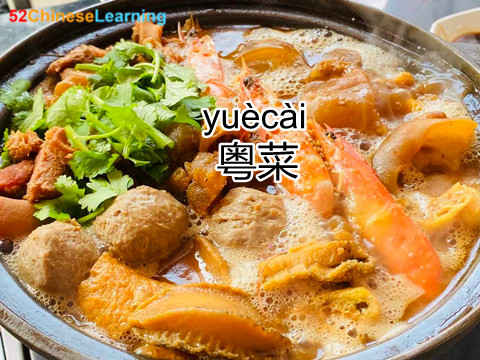Copy link succeeded! Now can share to friends.
Guangdong cuisine, abbreviated as Cantonese Chinese food, is one of the eight famous cuisines in China. It is composed of three local dishes, namely Guangzhou, Chaozhou, and Dongjiang Hakka cuisine. These three local cooking specialties have their own characteristics.
“Delicious food” is the main part of Guangzhou cuisine.

First, this cuisine considers the versatility of ingredients. Birds, animals, insects, and fish are raw materials, with various specialties. The second is to open the knife, to cook, and to cook on the spot. Guangdong Chinese food is a handy technique. They utilize basic to advanced knife skills. Third, the relevance and applicability of the food.
It must follow the weather. Food must be light in summer and autumn and fragrant in winter and spring Chaozhou cuisine plays an important role in Guangdong cuisine. Chaozhou cuisine is mainly made of seafood, river-fresh food, livestock, and poultry. It is good at cooking vegetables with vegetables and fruits as raw materials. It is processed in a variety of ways. It can be divided into frying, cooking, frying, braising, stewing, roasting, baking, marinating, smoking, bucking, soaking, rolling, and mixing. The knife work is skillful. It is quite difficult to replicate. The soup and vegetable skills are especially deep, Among them, stewed in clear soup, braised in brown sauce, and stewed in soup are the most distinctive.
Dongjiang cuisine, also known as Hakka cuisine, is mainly made of meat, which is original, crisp, soft, fragrant and strong. Hakka cuisine loves to play with fire. Consequently, they are known for stewing, roasting, boiling, and baking, especially for casseroles. The practice still retains some ingenious cooking skills, which have the style of the ancient Central Plains.
Guangdong cuisine has a wide range of exotic materials and cooking techniques that are quite dazzling. They utilize almost every living creature that inhabits that wild. That is one of the best factors of Guangdong cuisine. Despite The vast number of ingredients, at the chef’s hand, It immediately becomes exotic and delicious. Every dish has an intrinsic element that captivates customers
Another outstanding feature of Cantonese cuisine is the plenty amount of food per serving. It’s not cheap out. , its ingredients are numerous and skillful, and its decoration is beautiful and colorful. It is even good at innovation. It adapts other advanced techniques in cooking and incorporates it in the cuisine. That’s the reason for the variety of this cuisine. In 1965, “Guangzhou Famous Cuisine Beauty Exhibition” introduced 5,457 kinds of delicacies.
The third characteristic of Cantonese cuisine is that it pays attention to quality and taste. It opts for the appropriate taste and freshness. , Moreover, it changes with the seasons, focusing on lightness in summer and autumn, and on richness in winter and spring. The color, fragrance, taste, and style change according to the weather. However, something remains clear. The taste is always fresh, and the ingredients are tender. Cantonese cuisine always gives a refreshing, smooth, and fragrant piquancy; Seasoning is sour, sweet, bitter, spicy, and salty. These are the so-called five textures and six flavors.
Famous Cantonese dishes include roast suckling pig, boiled shrimp, Long Hudou, Taiye chicken, braised pork with taro, braised big skirt and wings, Huangpu scrambled eggs, stewed cereal, dog meat pot, multicolored fried snake shreds, chrysanthemum, dragon, tiger, phoenix, snake soup, etc., which are all famous Guangzhou dishes with local flavor.
Roast meat is usually eaten during the Qingming Festival. After all, it’s spring. The people’s living conditions are better now, and they also like to eat it during the Spring Festival. Generally, there were more roast pigs in Qingming Dynasty. They always roast the “adult” pork. When we eat roast meat, we will sprinkle some white sugar to add some flavor eat like this. People in other provinces are really not used to eating it.
Cantonese eat roast goose, but also dip it in sour plum sauce to add more flavor. The sauce is the peak combination of sweet and sour. On the other hand, the roast goose is fat but not greasy. The combination of goose and sauce is inevitable. Both accents the flavor of one another. , if not dipped in sauce, then you will get tired after eating a few pieces.
When it comes to sliced chicken, many people around me who are not Cantonese are particularly resistant to it. And white cut chicken is an indispensable classic Cantonese dish on the Guangdong table. Every new year, Cantonese people eat so much white cut chicken, that there’s not enough. An authentic white cut chicken should have blood on the bone and a little red in yellow. This deters many people from other provinces. They said that chicken with a little blood is uncooked. Therefore, they can’t eat white cut chicken.
The ancient Cantonese cuisine can be traced back to the Qin Dynasty. In the Southern Song Dynasty, because of the imperial kitchen, Cantonese cuisine developed rapidly. After the Opium War, Guangzhou, as one of the first batch of foreign ports, had frequent exchanges with foreign countries, and Cantonese cuisine absorbed some of the specialties of Western food.
At the same time, there are thousands of Cantonese restaurants in New York. With its unique charm of being free, wild, wild, and light, Cantonese cuisine has become a famous Chinese cuisine across the world. In terms of geographical location, Cantonese cuisine gradually formed in Guangzhou, Chaozhou, and Dongjiang. These are the major places for authentic Cantonese cuisine. However, it does include other places like Guangxi, Hainan, Taiwan, and more.
Your first 1-on-1 Chinese lesson offer